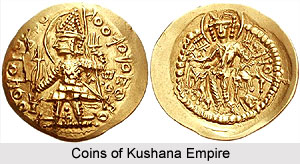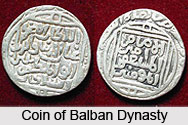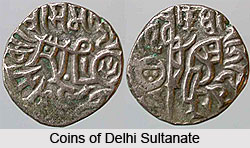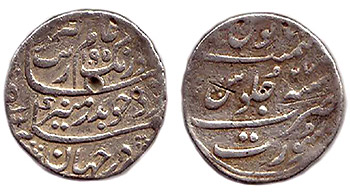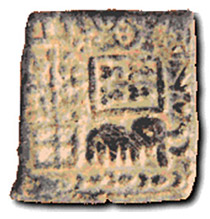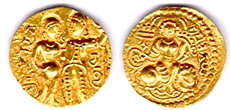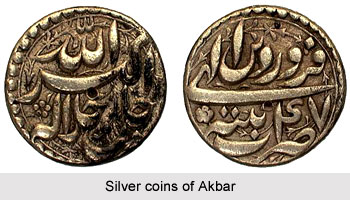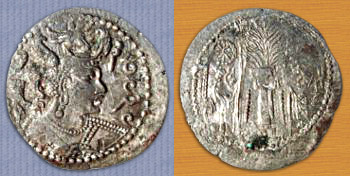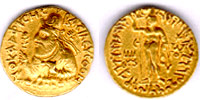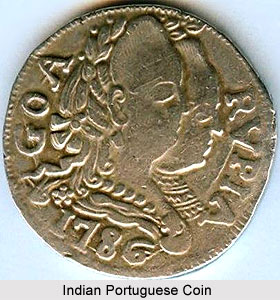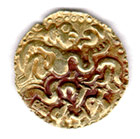 Cholas is an ancient dynasty of southern India having roots in Indian mythology. Cholas were great patrons of literature, philosophy, art and architecture. The gold coin of Sri lanka which was used as prototype by Raja Raja Chola when he conquored Shri Lanka. King (most likely) is shown sitting and holding conch in one hand. He took the title of `Lankavibhu`, the Lord of (Sri) Lanka. This title, which was written in Devnagri script, is seen on the obverse of coin.
Cholas is an ancient dynasty of southern India having roots in Indian mythology. Cholas were great patrons of literature, philosophy, art and architecture. The gold coin of Sri lanka which was used as prototype by Raja Raja Chola when he conquored Shri Lanka. King (most likely) is shown sitting and holding conch in one hand. He took the title of `Lankavibhu`, the Lord of (Sri) Lanka. This title, which was written in Devnagri script, is seen on the obverse of coin.
The Kadambas is an ancient dynasty of south India who primarily ruled the region, which is present day Goa state, and nearby Konkan region. Kadamba coins were one the heaviest and perhaps purest of all medieval Indian gold coinage, which were maintained with remarkable accuracy.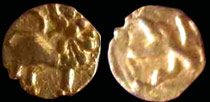 Kadambas issued the punch-marked coinage under influence of similar coinage of Jagadekamalla. The punch-marked gold coin, which is issued in name of Chalukya ruler Jaysimha II Jagadekamalla, has nine distinct punches on obverse while one punch on reverse. The punch on reverse was often struck in such a way that it is hardly visible on most coins, thus giving this series appearance of being uniface. The arrangement of symbols punched on this coin consists of a central punch mark-representing figure of monkey god, Hanumana, running to right and four retrospectant lions (dynastic emblem of Kadamba family at the cardinal points around the central punch mark. The two prominent punch marks create two Shri alphabets in Telugu-Kanarese script, which depicts Laxmi, goddess of wealth. The eighth punch mark creates a triangular motif and the ninth punch mark represents Telugu-Kanerese inscription on these coins, which reads JaGaDa. One specimen of this type of coin has an extra legend, engraved in Telugu-Kanarese script, which read TiVaRa giving us the name of the king as Shantivar.
Kadambas issued the punch-marked coinage under influence of similar coinage of Jagadekamalla. The punch-marked gold coin, which is issued in name of Chalukya ruler Jaysimha II Jagadekamalla, has nine distinct punches on obverse while one punch on reverse. The punch on reverse was often struck in such a way that it is hardly visible on most coins, thus giving this series appearance of being uniface. The arrangement of symbols punched on this coin consists of a central punch mark-representing figure of monkey god, Hanumana, running to right and four retrospectant lions (dynastic emblem of Kadamba family at the cardinal points around the central punch mark. The two prominent punch marks create two Shri alphabets in Telugu-Kanarese script, which depicts Laxmi, goddess of wealth. The eighth punch mark creates a triangular motif and the ninth punch mark represents Telugu-Kanerese inscription on these coins, which reads JaGaDa. One specimen of this type of coin has an extra legend, engraved in Telugu-Kanarese script, which read TiVaRa giving us the name of the king as Shantivar.
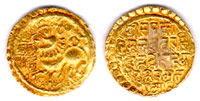 Toyimadeva (1065 AD) was ruler of this dynasty who perhaps issued first die struck gold coins. These coins are similar in weight and size to Kadambas of Goa. Compared to Goa Kadambas, coins of Kadambas of Hangal are relatively scarce and never been studied in greater details. The Kadambas of Goa mainly ruled in the Goa region and lime Hangal Kadambas, minted one of the finest examples of medieval Indian coinage. There is a coin minted by Shivachiita, the ruler of this dynasty. It shows lion walking on obverse. In front of the lion is the cyclical date, Visa.
Toyimadeva (1065 AD) was ruler of this dynasty who perhaps issued first die struck gold coins. These coins are similar in weight and size to Kadambas of Goa. Compared to Goa Kadambas, coins of Kadambas of Hangal are relatively scarce and never been studied in greater details. The Kadambas of Goa mainly ruled in the Goa region and lime Hangal Kadambas, minted one of the finest examples of medieval Indian coinage. There is a coin minted by Shivachiita, the ruler of this dynasty. It shows lion walking on obverse. In front of the lion is the cyclical date, Visa.
The Vijayanagar Empire lasted for 3 centuries and successfully prevented the extension of Muslim sultanetes in south. The coins of Vijaynagar Empire were very popular and were used as prototype even after its decline. Most dynasties in south (which include British and other European colonies) issued coins very similar to Vijaynagar coins till the begining of the eighteenth century.
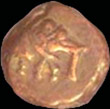 The Kingdom of Mysore was situated in Southwest India and was ruled by various Hindu dynasties. In 1761, Haider Ali a military adventurer deposed the Wodeyar ruler and proclaimed himself King. In the region, coins of both the Mughal and Vijayanagar standards were current. His coin issues coins of the pagoda types continued to carry the motifs and iconographic forms of the Vijayanagar period (e.g., Hara-Gauri) with his initial, the letter `He` on the reverse. Tipu, his son, succeed him and assumed the title of Sultan. He introduced various innovations and new varieties in his coinage, continuing with the pagodas, the mohurs, and introduced his own standards. An interesting feature of his coins is that they do not bear his name. Tipu Sultan, a progressive ruler, was one of the few Indian princes to perceive the imperial designs of the British and oppose them; he, however, was slain in the battle of Srirangpatanam in 1799 after which the British reinstated Krishna Raja Wodeyar as King of Mysore.
The Kingdom of Mysore was situated in Southwest India and was ruled by various Hindu dynasties. In 1761, Haider Ali a military adventurer deposed the Wodeyar ruler and proclaimed himself King. In the region, coins of both the Mughal and Vijayanagar standards were current. His coin issues coins of the pagoda types continued to carry the motifs and iconographic forms of the Vijayanagar period (e.g., Hara-Gauri) with his initial, the letter `He` on the reverse. Tipu, his son, succeed him and assumed the title of Sultan. He introduced various innovations and new varieties in his coinage, continuing with the pagodas, the mohurs, and introduced his own standards. An interesting feature of his coins is that they do not bear his name. Tipu Sultan, a progressive ruler, was one of the few Indian princes to perceive the imperial designs of the British and oppose them; he, however, was slain in the battle of Srirangpatanam in 1799 after which the British reinstated Krishna Raja Wodeyar as King of Mysore. Krishna Raja Wodeyar continued to issue coins of the Vijayanagar and Mughal standards. The gold coins carried the Hara-Gauri motif and the King`s name on the reverse. The silver coins were in the Mughal tradition, bearing the name of the Mughal Emperor, Shah Alam II on the obverse and the name of the mint on the reverse. Some of the smaller fraction coins carried the image of the deity Chamunda, the family deity of the Wodeyar family; other coins carried motifs drawn from nature and inscriptions in Nagri, Persian, Kannada, and English at various points of time.
Krishna Raja Wodeyar continued to issue coins of the Vijayanagar and Mughal standards. The gold coins carried the Hara-Gauri motif and the King`s name on the reverse. The silver coins were in the Mughal tradition, bearing the name of the Mughal Emperor, Shah Alam II on the obverse and the name of the mint on the reverse. Some of the smaller fraction coins carried the image of the deity Chamunda, the family deity of the Wodeyar family; other coins carried motifs drawn from nature and inscriptions in Nagri, Persian, Kannada, and English at various points of time.
The Princely State of Hyderabad was founded around 1724 when Mir Qamar-ud-Din, the Mughal Viceroy of the Deccan, assumed independence under the title of Asaf Jah and founded the dynasty of the Nizams of Hyderabad. In the post 1857 era, the State of Hyderabad was one of the largest Princely States in India and later came to be known as the `Dominion of His Exalted Highness, the Nizam`. The State, which covered territories presently, included in Andhra Pradesh, Maharashtra, and Karnataka was assimilated into the Indian Union in September 1948. In matters of currency and coinage, the coins of the Nizams were issued in the name of the Mughal Emperor till 1858 when a coin legend was introduced with the name of the founder of the state, Asaf Jha. Thereafter, they were struck independently and the new coins were termed the `Hali Sicca`, i.e., the current coins. In 1903-04 coins were machine struck for the first time. These coins featured the Charminar on the obverse with Persian inscription Nizam-ul-mulk Bahadur Asaf Jah around it. The reverse carried the value. These coins confirmed to the British coins in denominations and metals.
